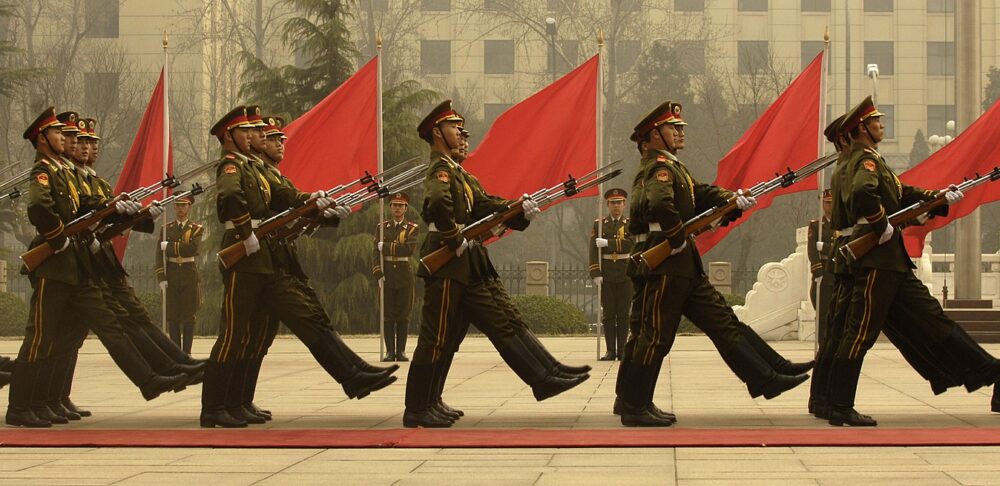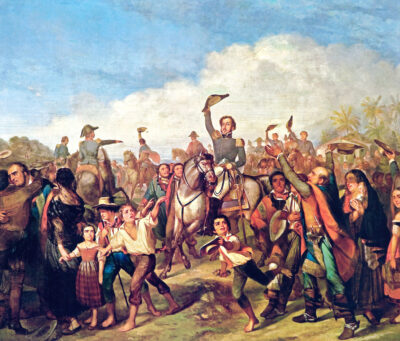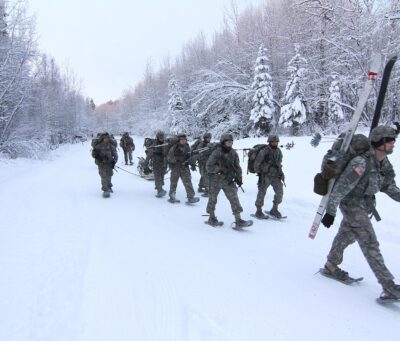“It was the rise of Athens and the fear that this instilled in Sparta that made war inevitable.” [1] Thucydides’ famous observation on great power conflict over two millennia ago remains true today. The spectacular rise of the People’s Republic of China (PRC) alarms the United States – and thereby Western society as whole – portending the ascent of a new hegemonic power. Since COVID’s global spread, Chinese diplomats have confirmed the West’s apprehensions by indicating through online discourse and hard power initiatives that China possesses an amplifying “ambition and capability to reform the global governance system to reflect Beijing’s priorities and values.” [2] [3] However, China does not desire direct confrontation with the West on all fronts that diplomats identify. Rather, part of China’s “Wolf Warrior Diplomacy” (WWD) – China’s aggressive foreign policy named after a popular action movie – stems from Chairman of the Chinese Communist Party and People’s Republic of China President Xi Jinping’s favored tactic to resolve domestic disputes. Nevertheless, continuing to employ this tactic could deliver disastrous consequences for Xi and hinder the PRC’s ability to achieve the domestic stability and reframing of international institutions it desires.
To understand why a Chinese diplomat described Australia as “gum stuck to the bottom of China’s shoe” to stir up nationalist sentiments, it is necessary to analyze the three primary origins of WWD. [4] First, the Chinese Communist Party (CCP) is performing a regime “legitimacy justification pivot.” Since the outset of the Deng Xiaoping era in 1978, the CCP derived its legitimacy from swiftly bolstering the Chinese standard of living. In recent years, however, this position has proved untenable as the 2008 financial crisis, the U.S. trade war, and COVID battered the PRC’s GDP growth rate from an annual nine and a half percent over the past 40 years down to one percent growth in 2020. [5] Similarly, other domestic government fumbling in censorship, social policies, human rights, and legal affairs have made legitimacy an “overriding issue.” [6] [7] Xi noted, “if we cannot solve [domestic] problems and let them get worse, the people will not trust and support us.” [8] Asserting national interests abroad has proven to be a “powerful legitimating ideology” to rejuvenate “social cohesion.” [9]
Second, Xi faces legitimacy crises of his own with the populace and elite. Xi has burnished his credentials as a patriot in popular imagination through his “Tigers and Flies Campaign,” a crusade to eliminate corrupt officials. His energetic pursuit of China’s global ambitions adds to this populist luster. To the masses, Xi’s ability to resolve decades-long struggles with corruption redounds to his credit. To the ruling class, however, this is viewed as a power grab, and has “created enemies among them.” [10] [11] Thus, as additional domestic reforms risk alienating elites further, Xi’s doubling down on foreign policy both sustains populist support and insulates Xi from “dissatisfied elites, who recognize that toppling a popular leader” advancing a strong international Chinese agenda “would invite backlash.” [12]
The final aspect of WWD emanates from anti-Western nationalism tied to China’s rise. Commencing with China’s defeat in the First Opium Wars in 1842, the nation endured over 100 years of Japanese and Western occupation and bullying, both diplomatically and economically, which the Chinese refer to as the “Century of Humiliation.” [13] Consequently, a staple of Chinese nationalism since the late 1800s has been the eviction of other powers from Chinese affairs and territorial claims. [14] The CCP claims to propagate the Chinese people’s desire to “return to a normal state of affairs,” where China reigns as the world’s hegemon, like it did during the Dynasty eras (emphasized throughout Chinese history textbooks). [15] [16] Allowing passionate nationalism to flourish online and in protests, the CCP now governs a population who, having been made to study the “Century of Humiliation,” are not opposed to employing “force to defend their territorial interests, including Taiwan.” [17] [18] While pursuing patriotic goals outwardly remains an effective tool for Xi and the CCP to ensure domestic stability, “a very nationalistic public makes foreigners very wary of China and harms China’s image.” [19]
Nevertheless, the Xi regime remains convinced that it must transform “Chinese diplomacy from conservative, passive, and low-key to assertive, proactive, and high-profile” to “signal high international status to boost domestic legitimacy.” [20] [21] This strategy manifests itself in two activities. First, diplomats darkly assert “bad consequences” and “firm counter measures” for those who oppose China’s repressions, human rights violations, territorial claims, COVID’s origin claims, etc. [22] [23] Second, this bluster is paired with Chinese hard power initiatives such as construction of artificial islands for military bases in the South China Sea, the Belt and Road Initiative (BRI), and Chinese entry into dual-purpose (military and private sector) technologies. The PRC has succeeded in mobilizing society to exhibit the “fighting spirit” towards the international community Xi’s desires; this aids him, and the CCP’s legitimacy claims. [24] [25]
Some scholars claim that this rhetoric stems from a coalition of diplomats lashing out beyond what the Party desires. Yet, there should be no question that WWD is coordinated. Beyond the aforementioned reasons why the PRC must “exaggerate its strength,” it is inconceivable that such provocative statements could be issued by members of an authoritarian foreign policy apparatus without a superior’s approval. [26] [27] The Central National Security Commission and the Central Foreign Affairs Commission, established by Xi himself to adhere directly to the Politburo and “key figures in the CCP,” can promptly suppress any unruly diplomat alleging, for example, that the United States military planted COVID within Wuhan. [28] [29] [30] [31]
Behaving aggressively abroad to redress discontent or difference at home is hardly unique to modern China, or ancient Athens and Sparta. German historian Fritz Fischer in his book Germany’s Aims in the First World War argues that Imperial Germany’s “dysfunctional domestic politics” induced its aggressive foreign policy before the First World War. [32]Half a century later, when President Harry Truman was choosing “ways to rally” the American people in support of his Cold War strategy, Senator Arthur Vandenberg, chairman of the Senate Foreign Relations Committee offered similar advice: “Make a personal appearance before Congress and scare the hell out of the American people.” [33] These examples iterate key lessons. Imperial Germany’s case shows how internal instability induces governments to promote threatening foreign policies to distract the masses. More worryingly, the example of the United States highlights how politicians, whether Truman or Xi, comprehend the personal benefits of the playbook: expounding on foreign dangers to stir public support for the necessity of their leadership.
What is unusual about the PRC’s positioning, however, is top officials’ private, persistent downplaying of assertive rhetoric as mere tactic of “diversionary aggression.” The editor of the Chinese Global Times, the government’s official newspaper, instructed then U.S. Ambassador John Huntsman “not to be concerned” as Chinese combativeness is simply “necessary to satisfy the Chinese people.” In a similar fashion, Organization Department Minister Li Yuanchao informed then U.S. National Security Adviser Tom Donilon that China “would not challenge the United States for global leadership.” Interestingly, Dr. Erin Baggott Carter of the University of Southern California noted “Beijing agreed to help with an Iran resolution at the United Nations, on one condition: that it could keep its assistance private.” [34] The disparity between on-camera and off-camera diplomacy is stark. In her research, Carter discovers the PRC quadruples its positive diplomacy in the month following a “diversionary aggressive” action. Carter’s conclusion that upwards of 40 percent of PRC aggression – both in rhetoric and in passive-aggressive military actions such as an aircraft fly-by – could be attributed to ‘diversionary aggression’ confirms the CCP both relies upon and must frequently invoke Chinese nationalism beyond its diplomatic goals. Still, PRC initiatives like BRI and increased participation in international agencies demonstrate the CCP’s serious commitment to establishing itself as a “strong country” on the world stage. [35] [36]
Regardless of the origins of the Party’s increasing verbal or physical clashes with other nations, overreliance upon the WWD tactic is unsustainable. The PRC will suffer geopolitical isolation should it continue to play the nationalist card. Domestically, constant “diplomatic spats with foreign powers” will deplete the number of times Xi can invoke “the peaceful identity of the Chinese people” to regain peace before the nationalist cries muffle the PRC’s messages. [37] As previously mentioned, with the CCP’s ‘legitimacy pivot’ shift to include achieving nationalist ends, eventually, some ends will have to be achieved to sustain legitimacy. Whatever bold maneuver the PRC performs when that time arises will surely affront the international community — such as an invasion of Taiwan. Yet, if WWD persists, the international community might already be exasperated with the PRC, as current WWD actions damage “China’s global image.” [38] [39]
Equally detrimental, as former Australian Prime Minister Kevin Rudd notes, “Chinese soft power runs the risk of being shredded.” [40] Unsurprisingly, the “war of competing narratives…competing political systems and…competing ideologies” in both soft and hard power arenas (like the sinking of a Vietnamese fishing vessel) has not only damaged China’s reputation, but also squandered some “geopolitical advantages China could have gained from” a post-COVID economy. [41] [42] [43] Now, disinformation in Africa about COVID’s origins are rejected by its intended audience. Additionally, the United States, the European Union, and the Quad now resolve to formulate “a coherent and robust China stance” which rebukes China’s economic and global governance initiatives. [44] [45]
Since World War Two, America has forged an extensive alliance network to flexibly counter rising hegemonic powers. Mobilizing our alliances – as when NATO entered in the War in Afghanistan – immensely diminishes the military and economic costs of confrontation while bolstering our side with the minds and material of our allies. As China chiefly leverages its economic might to induce powers into compliance with its Wolf Warrior narrative, the United States in turn must emphasize its status as a good actor while reiterating the lesson from the recent Ukrainian invasion: bad actors left unchecked produce chaos. As the PRC plans to use its stranglehold of key resources to compel acceptance of its further moves, it should remember that Russia also believed its dominance of European energy exports would ensure nations like Germany would keep out. Instead, Germany abandoned the Nord Stream 2 Pipeline, sent military supplies to Ukraine, and joined other Western powers in restricting Russia from international financing. Similarly, Australia, Japan, and other Asian powers have already demonstrated their willingness to oppose the PRC on key issues despite massive economic blowback. If the United States brings our experience to forge another “moral alliance” against encroaching authoritarianism – armed with the recent potent example of Ukraine – the PRC will be boxed into playing by the economic and moral rules established by Washington, less endure conflict against most of the developed world as well as a region aggravated by the PRC’s power plays.
In his recent book, Destined For War, Graham Allison uses “Thucydides’s Trap” in describing Sino-American relations. In the past 500 years, a rising power threatening to displace a ruling one has resulted in war in twelve of the sixteen instances. Though a bleak statistic, he notes the four peaceful cases, three of which occurred in the twentieth century; all derived from imaginative statecraft. [46] Forgetting Deng’s cautions to “hide and bide” while continuing to pursue WWD on the international stage against a multinational hegemonic coalition will only drive China down a path of destabilization by internal or external forces. To safeguard against another “Century of Humiliation” replete with domestic turmoil and Western bullying, Xi and the CCP – “the wolves” – must develop new tactics that redirect nationalism and reframe China’s legitimacy.
David (Trace) Held III ’24 is the Director of Operations for the AHS chapter at Indiana University, where he is studying Finance with a self-created minor in Chinese-U.S. Relations.
—
Notes:
[1] Graham Allison, “Thucydides Trap: An Overview,” Harvard Kennedy School Belfer Center, 2019, https://www.belfercenter.org/thucydides-trap/overview-thucydides-trap.
[2] Benjamin Tze Ern Ho, “China’s Strategic Objectives in a Post COVID-19 World,” PRISM 9, no. 1, 2020, 89-101.
[3] Graham Allison, “Trace China’s Rise to Power,” Council on Foreign Relations, 12 November 2020, from https://www.cfr.org/china-global-governance/.
[4] IntelBrief, “The Rise of ‘Wolf Warrior’ Diplomacy from China,” The Soufan Center, 30 July 2020, https://thesoufancenter.org/intelbrief-the-rise-of-wolf-warrior-diplomacy-from-china/.
[5] Christopher W. Bishop, “To Understand China’s Aggressive Foreign Policy, Look at Its Domestic Politics,” Council on Foreign Relations, 12 November 2020, https://www.cfr.org/blog/understand-chinas-aggressive-foreign-policy-look-its-domestic-politics.
[6] Wayne M. Morrison, “China’s Economic Rise: History, Trends, Challenges, and Implications for the United States,” (Washington DC: Congressional Research Service, 25 June 2019), 1-41, https://www.everycrsreport.com/reports/RL33534.html.
[7] Tarun Chhabra & Ryan Hass, “Global China: Domestic politics and foreign policy,” Brookings, September 2019, https://www.brookings.edu/research/global-china-domestic-politics-and-foreign-policy/.
[8] Verna Yu, “Communist Party powered by history? Why China’s one-party rule is facing a legitimacy crisis,” South China Morning Post, 11 November 2020, https://www.scmp.com/news/china/policies-politics/article/1865965/legitimacy-crisis-facing-chinas-communist-party.
[9] Yu.
[10] Erin B Carter, “Diversionary aggression in Chinese foreign policy,” Brookings, 22 January 2019, https://www.brookings.edu/articles/diversionary-aggression-in-chinese-foreign-policy/.
[11] Bishop.
[12] Carter.
[13] Patricia Ebrey, “Introduction to China’s Modern History: Asia for Educators Columbia University,” Weatherhead East Asian Institute Columbian University, 2020, http://afe.easia.columbia.edu/timelines/china_modern_timeline.htm.
[14] Uradyn E. Bulag, “Nationality,” Afterlives of Chinese Communism: Political Concepts from Mao to Xi (Canberra: Australian National University Press, 2019), 152.
[15] Erwin Blaauw, “The driving forces behind China’s foreign policy – has China become more assertive?,” RaboResearch, 23 October 2013, https://economics.rabobank.com/publications/2013/october/the-driving-forces-behind-chinas-foreign-policy-has-china-become-more-assertive/.
[16] Bulag, 156.
[17] Kai Quek, “Nationalism in China is running high. Here’s how Beijing reins it in,” The Washington Post, 1 June 2020, https://www.washingtonpost.com/politics/2020/06/01/nationalism-china-is-running-high-heres-how-beijing-reins-it/.
[18] Magnus Langset Trøan, China’s EU Policy in the Pandemic Era A New Normal, (Oslo: Norwegian Institute of International Affairs, 2020), 1-4, https://www.jstor.org/stable/resrep25737.
[19] Jayshree Bajoria, “Nationalism in China,” Council on Foreign Relations, 22 April 2008, https://www.cfr.org/backgrounder/nationalism-china.
[20] Borge Bakken, “Rebranding China: Contested Status Signaling in the Changing Global Order, by Xiaoyu Pu,” The University of Chicago Press Journals, 1 July 2020, https://www.journals.uchicago.edu/doi/10.1086/708976.
[21] Zhu Zhiqun, “Interpreting China’s ‘Wolf-Warrior Diplomacy,’” The Diplomat, 16 May 2020, https://thediplomat.com/2020/05/interpreting-chinas-wolf-warrior-diplomacy/.
[22] Jamie Dettmer, “China’s ‘Wolf Warrior’ Diplomacy Prompts International Backlash,” Voice of America, 6 May 2020, https://www.voanews.com/covid-19-pandemic/chinas-wolf-warrior-diplomacy-prompts-international-backlash.
[23] Hung Tran, One World, Two Systems’ Takes Shape During the Pandemic, (Washington, D.C.: Atlantic Council Geoeconomics Center, September 2017), 1-12, https://www.jstor.org/stable/resrep26003.
[24] Yun Sun, Managing the Fallout of the US-China Trade War, (Washington, D.C.: Stimson Center, 1 October 2019), 1-3, https://www.jstor.org/stable/resrep20056.
[25] Zhiqun.
[26] Ragul Palanisami, “Opinion – Making Sense of China’s ‘Wolf Warrior’ Diplomacy,” E-International Relations, 10 August 2020, https://www.e-ir.info/2020/08/10/opinion-making-sense-of-chinas-wolf-warrior-diplomacy/.
[27] Bakken.
[28] Ho, 90.
[29] Zhiqun.
[30] IntelBrief.
[31] Palanisami.
[32] Bishop.
[33] Christopher A. Preble, Peace, War, and Liberty: Understanding U.S. Foreign Policy (Washington, D.C.: Cato Institute), 2019, 82-83.
[34] Carter.
[35] Bakken.
[36] Carter.
[37] Quek.
[38] Carter.
[39] Sun.
[40] Dettmer.
[41] Tran.
[42] Zhiqun.
[43] IntelBrief.
[44] Burgess Laird, “WAR CONTROL: Chinese Writings on the Control of Escalation in Crisis and Conflict,” Center for a New American Security, 2017, 1-32.
[45] Stuart Lau, “Europe is ready to team up with Joe Biden on China,” South China Morning Post, 10 November 2020, https://www.scmp.com/news/china/diplomacy/article/3109237/europe-ready-team-joe-biden-china.
[46] Graham Allison, Destined For War: Can America and China Escape Thucydides’s Trap?, (Boston, MA: Mariner Books), 2017.
Image: “Chinese honor guard in column,” by Staff Sgt. D. Myles Cullen (USAF), retrieved from https://commons.wikimedia.org/wiki/File:Chinese_honor_guard_in_column_070322-F-0193C-014.JPEG. This image or file is a work of a U.S. Air Force Airman or employee, taken or made as part of that person’s official duties. As a work of the U.S. federal government, the image or file is in the public domain in the United States.



